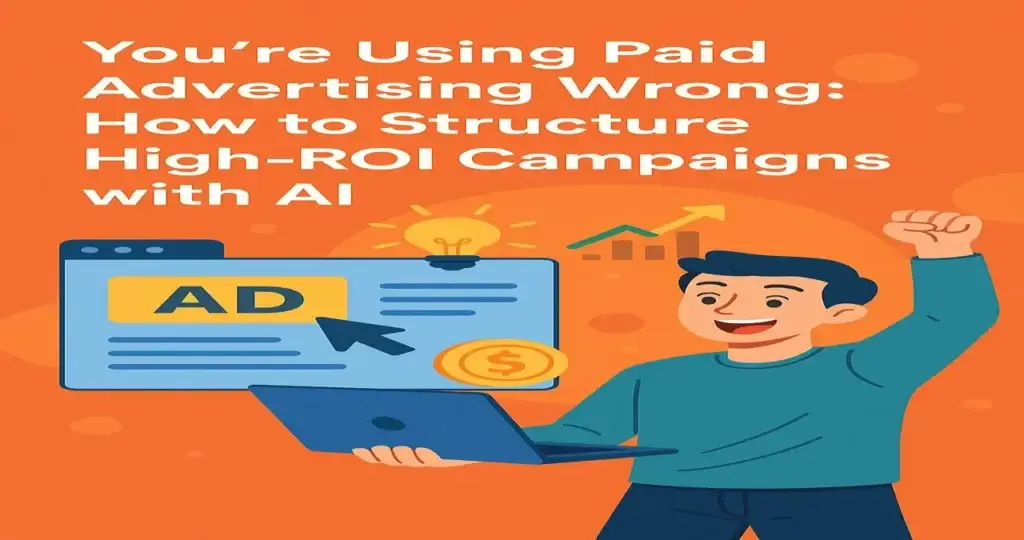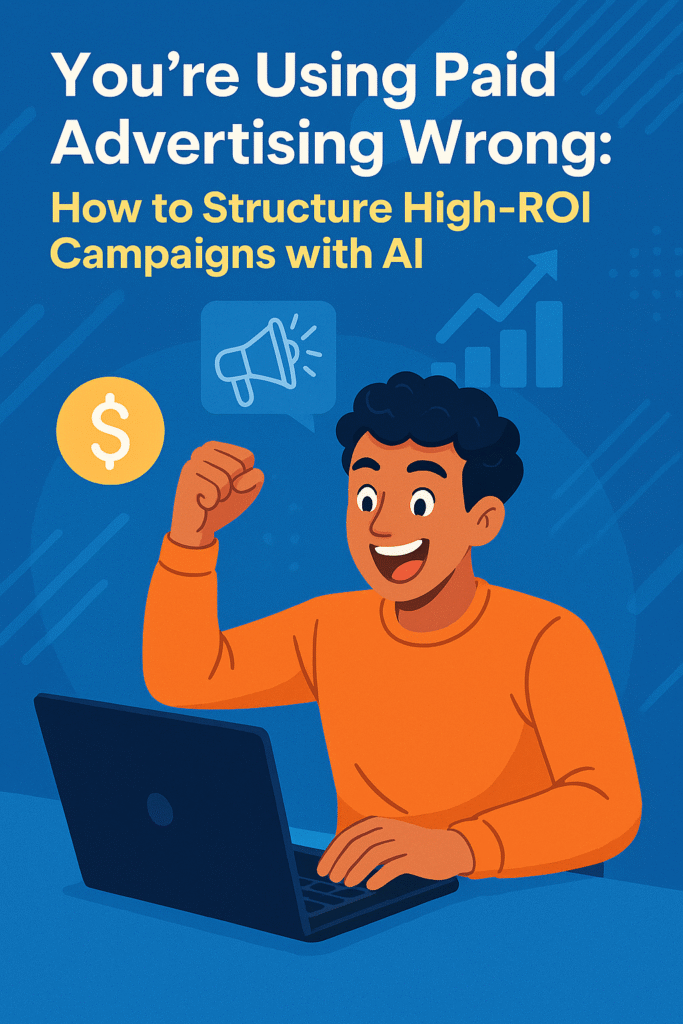Paid advertising is a powerful tool—but most marketers are leaving money on the table. Whether you’re running Google Ads, Facebook campaigns, or LinkedIn promotions, the difference between a mediocre ROI and a high-performing campaign often comes down to structure, strategy, and how well you leverage AI.
In this guide, we’ll break down how to stop wasting your paid advertising budget and start building campaigns that convert—using smart prompting techniques and AI tools that actually work.

Why Most Paid Ads Fail ?
Running paid ads can feel like guessing and hoping something works. You set up a campaign, pick some keywords, write a few lines of copy, and hope for the best. But here’s the catch—Google Ads and other platforms reward precision, not guesswork.
Common mistakes in paid advertising:
- Targeting too broad or irrelevant keywords
2. Writing generic ad copy that doesn’t resonate
3. Poor landing page alignment
4. Ignoring audience intent signals
5. Not using AI to optimize or iterate
Imagine trying to sell umbrellas in a desert. That’s what happens when your paid ads don’t match user intent. AI can help you avoid this by analysing patterns, predicting behaviour, and generating hyper-relevant content—if you know how to prompt it correctly.
Structuring Paid Advertising Campaigns for Maximum ROI
Before diving into AI prompts, let’s talk structure. A well-organized campaign is like a well-oiled machine. Here’s how to build one:
Segment by Intent, Not Just Keywords
Instead of lumping all keywords into one ad group, break them down by user intent. For example:
Intent Type Keyword Example Ad Message Focus
Informational “What is PPC?” Educate and build trust
Navigational “Google Ads dashboard” Help users find tools
Transactional “Buy PPC services” Highlight offers and urgency
This structure ensures your paid advertising campaigns speak directly to where the user is in their journey.
Use AI to Generate Ad Variants
AI tools like ChatGPT or Gemini can help you write multiple ad versions quickly. But the magic lies in how you prompt them.
Prompting Techniques That Supercharge Paid Ads with AI
Prompting isn’t just typing a question—it’s strategic communication. Here’s how to get AI to deliver high-converting ad copy:
Technique 1: Role-Based Prompting
Tell the AI who it is and what it’s doing.
Prompt Example:
“You are a Google Ads expert writing transactional ad copy for a PPC agency targeting small businesses. Write 3 variations with urgency and a clear CTA.”
This sets context and tone, helping the AI generate focused results.
Technique 2: Layered Inputs
Feed the AI structured data like keyword lists, audience personas, and product benefits.
Prompt Example:
“Using the keyword ‘paid advertising for startups’, write ad copy that appeals to budget-conscious founders. Highlight ROI and simplicity.”
The clearer your instructions, the better results you’ll get!
Technique 3: Iterative Refinement
Don’t settle for the first draft. Ask the AI to improve based on performance metrics or tone.
Prompt Example:
“Revise this ad to increase CTR by adding emotional appeal and urgency. Keep it under 90 characters.”
This turns AI into your creative partner, not just a copy machine.
Real-World Example: Turning a Low-Performing Campaign Around
Let’s say you’re running a paid advertising campaign for a SaaS tool. Your CTR is flat, and conversions are low. You use AI to:
Segment keywords by intent (e.g., “best SaaS for freelancers” vs. “SaaS pricing plans”)
Prompt AI to write tailored ad copy for each segment
A/B test the variants and feed performance data back into the AI for refinement
Result? A 40% increase in CTR and a 25% drop in cost-per-conversion.
It’s like upgrading from a flip phone to a smartphone—same function, wildly better results.
Bonus: AI Tools That Elevate Paid Advertising
Here are a few tools that pair beautifully with smart prompting:
Tool Name Use Case Why It Works
ChatGPT / Gemini Ad copy generation Fast, flexible, and creative
Copy.ai Headline and CTA suggestions Built for marketers
Jasper Long-form ad content Great for landing pages
Surfer SEO Keyword clustering Aligns content with search intent
Combine these with Google Ads’ built-in AI features (like Performance Max) and you’ve got a powerhouse setup.
Final Thoughts: Paid Advertising Is a Science—AI Is Your Lab Partner
If you’re still treating paid ads like a guessing game, it’s time to evolve. With the right structure and AI prompting techniques, you can turn your campaigns into ROI machines. Learn how to increase your quality score.
Remember: paid advertising isn’t just about spending money—it’s about spending smart. And AI gives you the edge to do just that.
Share this with your team or fellow marketers who are still stuck in the “spray and pray” phase. Let’s make paid ads smarter, together.
Book your free consultation now!
Call us: [9821556491]
Visit: [aradhyadhyani.com]
What is PPC and how does it differ from other billing models?
PC (Pay-Per-Click) charges advertisers only when someone clicks on their ad. It’s ideal for performance-driven campaigns. Other models include:
CPM (Cost Per Mille): Pay per 1,000 impressions—best for brand awareness.
CPA (Cost Per Acquisition): Pay when a user converts—great for ROI-focused campaigns.
How does Quality Score affect ad performance?
Quality Score (1–10) reflects the relevance of your ad, keyword, and landing page. A higher score:
Lowers your CPC
Improves ad rank
Enhances visibility It’s influenced by CTR, keyword relevance, and landing page experience
What is competitive analysis in paid advertising?
It’s the process of evaluating your competitors’ ad strategies—keywords, creatives, bidding, and platforms. This helps you:
Identify gaps and missed opportunities
Benchmark performance
Refine your own campaigns for better ROI.
Which metrics should I track to analyse paid ad performance?
Key metrics include:
CTR (Click-Through Rate): Measures engagement
CVR (Conversion Rate): Tracks effectiveness
CPC (Cost Per Click): Indicates cost-efficiency
ROAS (Return on Ad Spend): Evaluates profitability
How do I optimize a Google Ads campaign post-launch?
Post-campaign optimization involves:
Segmenting audience data
Identifying high-performing keywords and creatives
Adjusting bids and targeting
Enhancing landing page UX Use tools like Google Ads Editor and Analytify for deeper insights


My brother suggested I might like this blog He was totally right This post actually made my day You can not imagine simply how much time I had spent for this info Thanks
Simply wish to say your article is as amazing The clearness in your post is just nice and i could assume youre an expert on this subject Well with your permission let me to grab your feed to keep updated with forthcoming post Thanks a million and please carry on the gratifying work
I was recommended this website by my cousin I am not sure whether this post is written by him as nobody else know such detailed about my trouble You are amazing Thanks
Your blog is like a beacon of light in the vast expanse of the internet. Your thoughtful analysis and insightful commentary never fail to leave a lasting impression. Thank you for all that you do.